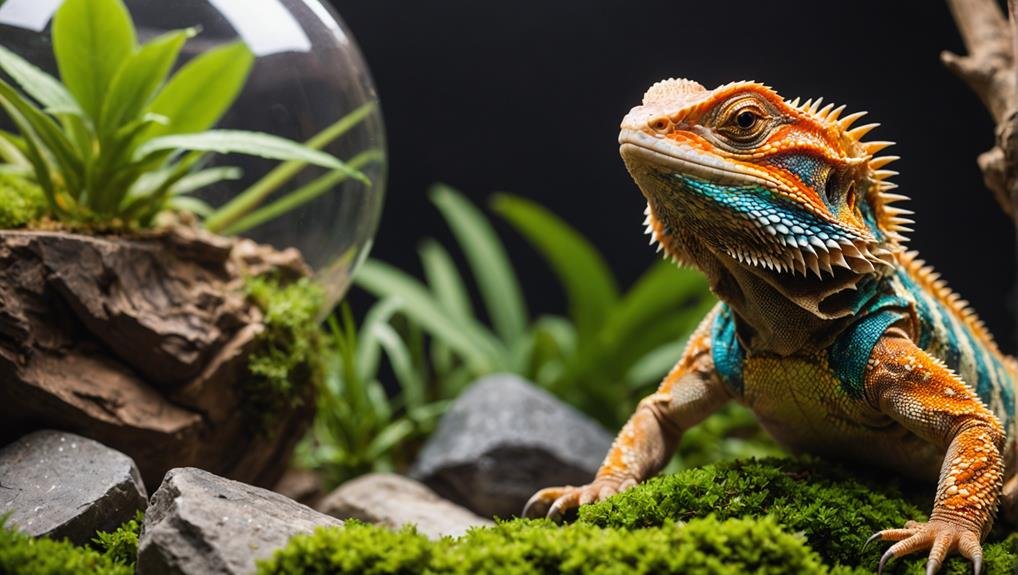When you observe your bearded dragon’s head bobbing, it’s not just a random action but a complex communication form. This behavior can indicate dominance, territorial claims, or even be a part of mating rituals. But what if the head bobbing seems excessive or out of context? Understanding the nuances and triggers behind this motion can be essential for your pet’s well-being. You’ll want to know how to distinguish between normal and concerning behaviors and what steps to take to guarantee your bearded dragon remains healthy and stress-free.
Key Takeaways
- Head bobbing signifies dominance, territorial behavior, and communication among bearded dragons.
- Male bearded dragons use head bobbing as part of courtship displays during mating season.
- Environmental changes such as lighting and temperature can trigger stress-induced head bobbing.
- Female head bobbing is slower and less aggressive, often related to communication and mating rituals.
- Persistent or intense head bobbing might indicate stress or health issues; seek veterinary advice.
Reasons for Head Bobbing
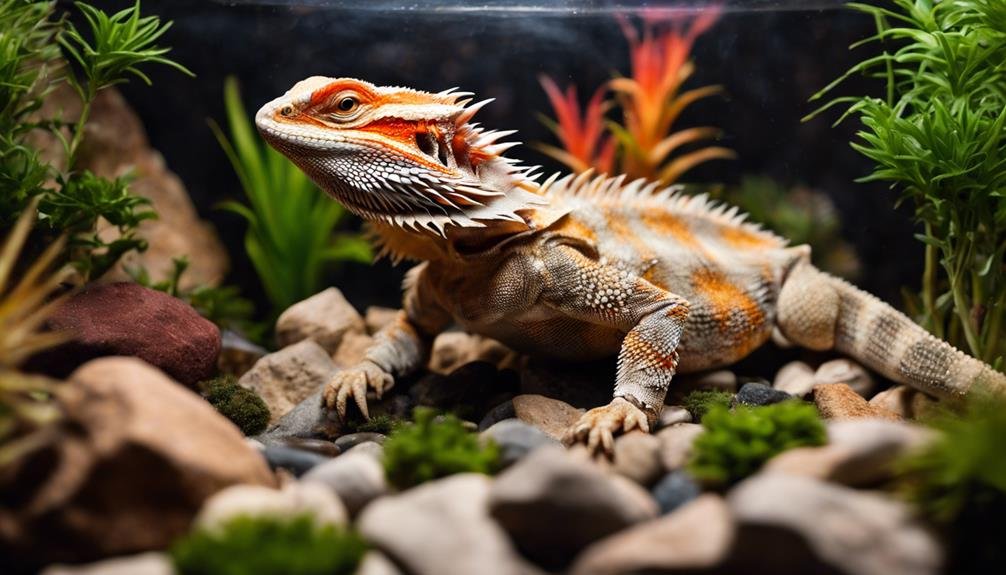

Even though it may seem peculiar at first, bearded dragons’ heads bob for several reasons; one of the primary reasons is to communicate with others. This behavior can indicate dominance, submission, or interest in their environment. For instance, a bearded dragon might head bob in response to stress or aggression, signaling how it feels in a given situation.
When you notice your bearded dragon head bobbing, it could also be related to mating behavior. Male bearded dragons often bob their heads to attract a mate, showcasing their presence and readiness. This head shaking can be quite rapid and intense during mating season.
Female bearded dragons may also engage in head bobbing, though it’s typically slower and less aggressive.
Changes in surroundings can also trigger bearded dragon head bobbing. If you’ve recently altered their habitat or introduced new elements, your pet might bob its head as a reaction to these changes. By monitoring the frequency, context, and intensity of the head bobbing, you can gain valuable insights into your bearded dragon’s behavior and well-being. Understanding why bearded dragons bob their heads helps ensure they’re comfortable and content.
Dominance and Territory
Regarding bearded dragons, head bobbing often signifies dominance and territorial behavior. If you see your bearded dragon’s head shaking, it’s likely trying to assert its dominance or establish its territory. This behavior is common among bearded dragons and can occur in various situations.
Here are four key points to help you comprehend this behavior:
- Assertion of Dominance: Bearded dragons use head bobbing to display their dominance over other dragons. It indicates they want to be acknowledged as the alpha.
- Territory Establishment: When a bearded dragon feels its space is threatened, it will head bob to designate its territory and ward off potential threats.
- Communication: Head bobbing acts as a form of communication among bearded dragons, aiding in avoiding physical confrontations by clearly signaling intentions.
- Context Matters: Observing the context and frequency of head bobbing can give you insights into your bearded dragon’s social interactions and overall behavior.
Understanding these aspects can help you better care for your bearded dragon and ensure it feels secure in its environment. Knowing why your dragon is head bobbing is crucial for addressing its needs properly.
Mating and Reproductive Behavior
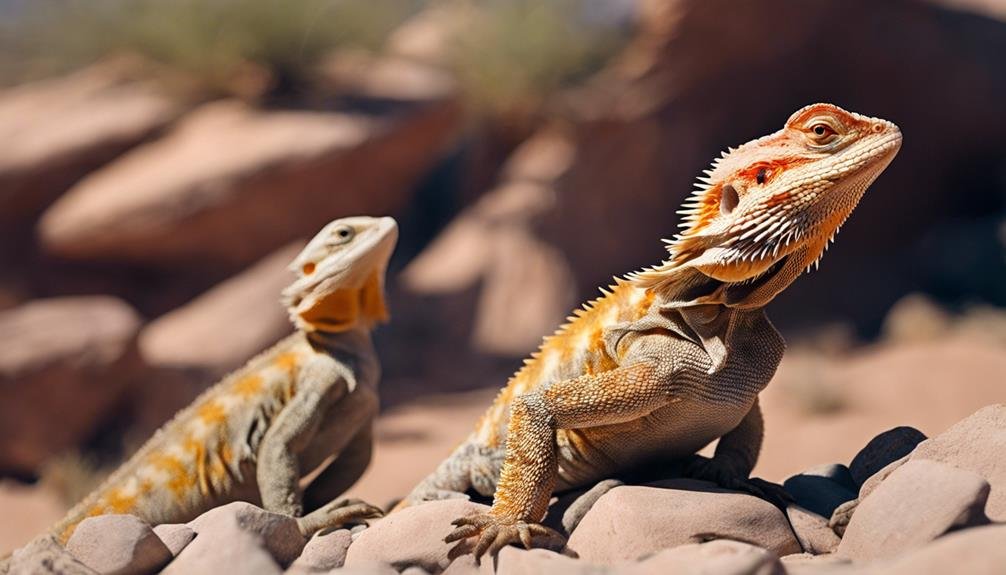

While head bobbing often denotes dominance and territorial behavior, it also plays a significant role in bearded dragons’ mating and reproductive activities. During mating season, you’ll observe males engaging in head bobbing as part of their mating rituals to attract females. These courtship displays are essential for initiating communication and signaling their interest.
Females may respond to these displays with head bobbing, indicating their receptiveness. This exchange is a pivotal part of the complex mating behavior, which also includes tail waving and body posturing. By interpreting these signals, bearded dragons can gauge their potential mate’s readiness and willingness to breed.
Understanding these behaviors can help you provide appropriate care during the breeding season. For instance, creating an environment that supports these natural behaviors, such as providing ample space and proper lighting, can facilitate successful mating. Recognizing the significance of head bobbing in the context of mating can also help you differentiate between courtship displays and other forms of communication like dominance or stress. Doing so ensures your bearded dragons are healthy and comfortable during this critical period.
Stress and Environmental Triggers
Bearded dragons might exhibit head bobbing as a direct response to various environmental stressors. Changes in lighting, temperature, or surroundings can trigger this behavior. When bearded dragons bob their heads, it’s sometimes a way of showing dominance or reacting to new, potentially unsettling stimuli in their habitat.
To manage and minimize these stress-induced head-bobbing episodes, consider these steps:
- Monitor Environmental Changes: Sudden shifts in lighting, temperature, or adding new objects can cause stress. Keep a consistent environment to help your dragon feel secure.
- Reduce Sudden Noises: Loud or unexpected sounds can be startling. To minimize these disruptions, place the enclosure in a quiet area of your home.
- Observe Head Bobbing Patterns: Pay attention to the duration and intensity of head bobbing. This can help you pinpoint specific stressors impacting your dragon.
- Consult a Specialist: If stress-induced head bobbing persists, seek advice from a reptile specialist. They can provide tailored guidance on managing environmental triggers and creating a stress-free habitat.
Health and Well-being
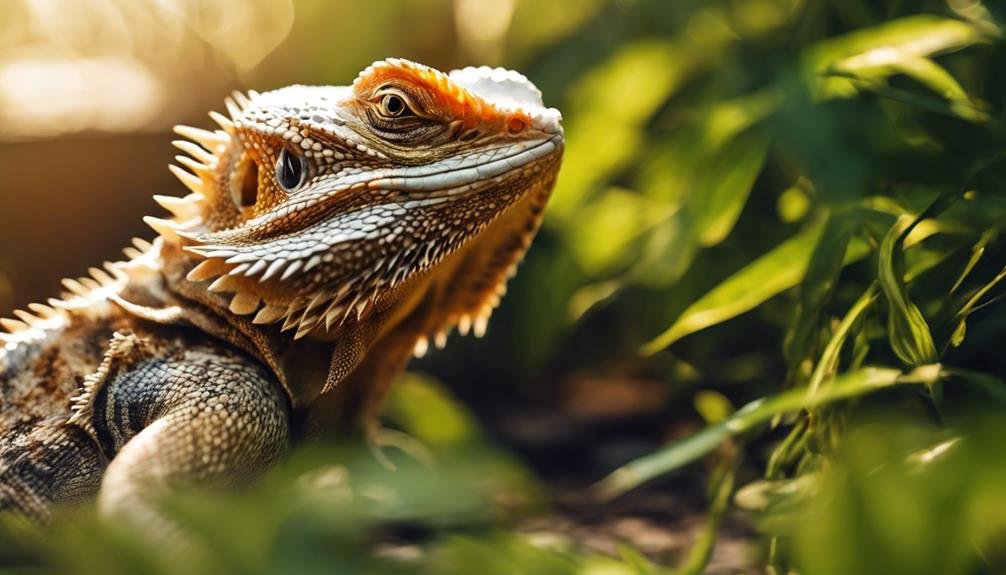

Maintaining the health and well-being of your bearded dragon hinges on several key factors.
First, a proper diet is essential. Ensure your bearded dragon enjoys a balanced diet that includes live feeder insects and fresh produce. This keeps them energetic and supports their overall health.
Lighting and temperature control are also vital. Bearded dragons need UVB lighting and the right temperature gradient in their enclosure to thrive. Without this, they might develop metabolic bone disease or other health issues.
Another crucial element is creating a stress-free environment. Monitor stress triggers such as an improper diet or a poorly set-up habitat. If your male bearded dragon starts bobbing his head excessively, it could be a sign of stress or territorial behavior. Address these triggers promptly to promote a calm living space.
Regular veterinary check-ups are essential. They help catch early signs of illness or lack of appetite before they become severe. Any sudden behavioral changes, including how often bearded dragons bob their heads, should be promptly addressed with your vet.
Gender Differences in Behavior
A balanced diet, proper lighting, and a stress-free environment are pivotal for your bearded dragon’s health, but understanding their behavior is equally important. Female bearded dragons bob their heads for various reasons, which can help you decode their needs and emotions. Head bobbing isn’t just a male trait; females often use it to communicate.
Here are four key points to understand about female bearded dragons bobbing their heads:
- Communication: Female bearded dragons bob their heads to communicate with other dragons or you. This can be a greeting or a way to get your attention.
- Dominance Assertion: In a group setting, females may display head bobbing to assert dominance over other dragons. It’s their way of establishing a pecking order.
- Mating Rituals: During mating season, female bearded dragons often bob their heads as part of courtship behaviors, signaling their readiness to mate.
- Environmental Responses: Changes in their environment can trigger head bobbing. Observing the frequency and intensity can provide insights into their comfort levels and overall well-being.
Normal Vs. Abnormal Signs
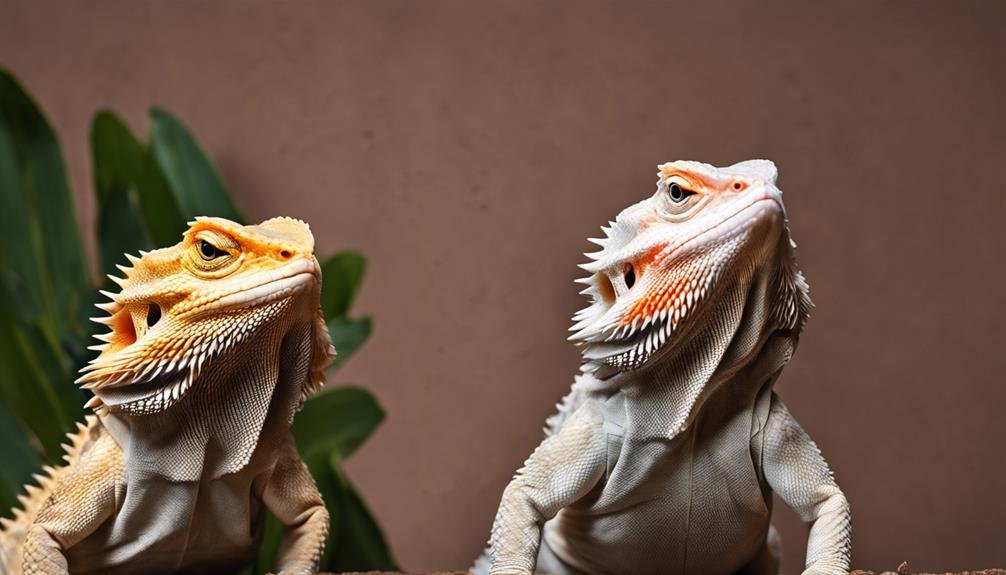

How can you tell if your bearded dragon’s head bobbing is normal or a sign of something more concerning? Normal head bobbing in dragons typically happens occasionally and can be a form of communication or a display of dominance. However, if you notice excessive or continuous head shaking, it might indicate underlying health issues.
Monitoring the frequency and context of your dragon’s head movements is pivotal. Environmental factors, like changes in tank setup or lighting, can trigger normal head bobbing. If your dragon’s head bobbing persists despite a stable environment, a visit to the vet is recommended.
Here’s a quick guide to help you differentiate between normal and abnormal head bobbing:
| Normal Head Bobbing | Abnormal Head Bobbing |
|---|---|
| Occasional | Excessive or continuous |
| Communication | Possible health issues |
| Display of dominance | Persists despite the stable environment |
| Environmental triggers | Unrelated to environmental changes |
| Monitor but not urgent | Vet visit recommended |
Expert Tips and Recommendations
To better understand your bearded dragon’s head bobbing, monitor environmental changes and their effects to identify any stress triggers.
Consult a reptile vet and experienced owners for tailored advice on ensuring proper care.
Promptly address any abnormal behaviors to maintain your pet’s well-being.
Identifying Stress Triggers
Identifying stress triggers in your bearded dragon’s environment can greatly enhance their well-being. When your bearded dragon bobs its head or displays a black beard, it might react to stress. To optimize your pet’s comfort, you need to monitor for potential stressors and address them promptly.
Here are some expert tips to help you identify and mitigate stress triggers:
- Evaluate Diet and Lighting: Ensure your bearded dragon’s diet is balanced and that their enclosure has proper lighting. Incorrect UVB lighting or diet can lead to stress signs, such as head bobbing or a black beard.
- Check Temperature Gradients: Make sure the enclosure maintains correct temperature gradients. Both hot and cool zones are essential for regulating body temperature, and incorrect temperatures can cause noticeable stress.
- Observe Environmental Changes: Any disruptions, such as additions to the enclosure or sudden movements, can stress your bearded dragon. Try to keep their environment stable and predictable.
- Seek Expert Advice: Consult experienced reptile owners or veterinarians to identify and eliminate potential stressors. They can provide tailored advice and help you create optimal living conditions for your bearded dragon.
Monitoring Environmental Changes
Regularly monitoring environmental shifts in your bearded dragon‘s habitat reduces stress and prevents excessive head bobbing. Bearded dragon owners should keep a close eye on lighting, temperature, and habitat setup adjustments. Any sudden changes can become stressors, causing your bearded dragon, Bob, to exhibit increased head-bobbing behavior.
It’s vital to maintain consistency in Bob’s environment. This means ensuring the temperature gradient and UVB lighting stay stable, as fluctuations can lead to discomfort and stress. Additionally, take note of any new additions to the enclosure, such as decor changes or new plants, which might impact Bob’s behavior. Even minor alterations can be significant for a bearded dragon.
If you notice increased head bobbing, carefully examine recent environmental changes. Recording these adjustments can help you identify and eliminate potential stressors.
In some cases, despite your best efforts, the root cause mightn’t be obvious. When this occurs, seek advice from reptile experts or veterinarians. They can provide insights into environmental factors that might be contributing to Bob’s head bobbing and suggest effective solutions to ensure your bearded dragon’s well-being.
Ensuring Proper Care
Taking proper care of your bearded dragon ensures they thrive in their environment. Proper care involves basic needs and attention to detail that can prevent stress-related behaviors like head bobbing. Here are some expert tips and recommendations:
- Diet: Guarantee your bearded dragon has access to a proper diet consisting of live feeder insects and fresh vegetables. This balanced diet supports their overall health and reduces stress that could lead to bobbing behaviors.
- Lighting and Temperature: Maintain the correct lighting and temperature levels in your dragon’s enclosure. Proper UVB lighting and a temperature gradient are essential for their well-being and can prevent stress-induced bobbing.
- Living Environment: Provide adequate hiding spots and enrichment activities to create a comfortable and stress-free environment. A well-set-up habitat can noticeably reduce anxiety and associated bobbing.
- Monitoring and Guidance: Regularly monitor your dragon’s behavior, appetite, and appearance for signs of illness or discomfort. Don’t hesitate to seek guidance from experienced reptile owners or veterinarians if you notice any issues.
Conclusion
Understanding your bearded dragon’s head bobbing is essential for ensuring their well-being. You’ll foster a better relationship with your pet by recognizing the reasons behind this behavior—dominance, mating, stress, or health. Keep an eye on environmental triggers and consult experts when needed. Remember, correctly interpreting these signals can significantly affect your bearded dragon’s happiness and health. Stay attentive and responsive to their needs for a thriving pet.
FAQs
1. Why Is My Bearded Dragon Head Bobbing?
Your pet’s head bobbing is body language used for communication. It could signal stress or aggression. Check for changes in their environment or health issues. If it’s excessive, consult a vet for a thorough evaluation.
2. Why Is My Bearded Dragon Glass Surfing and Head Bobbing?
Your bearded dragon’s glass surfing and head bobbing are stress indicators and behavioral cues. These actions often reflect territorial behavior or dominance displays. Address environmental factors like tank size and lighting to minimize these stress-induced behaviors.
3. What Does It Mean When a Lizard Bobs Its Head?
When a lizard bobs its head, it’s often an aggressive display or territorial behavior. It can also be part of a mating ritual as a communication signal to attract a mate or assert dominance in its environment.
4. Why Do Bearded Dragons Shake Their Heads Up and Down?
Bearded dragons shake their heads as a form of behavioral communication and territorial displays. They’re asserting dominance, engaging in mating rituals, or responding to stress. Understanding this helps you interpret and address your dragon’s needs.

